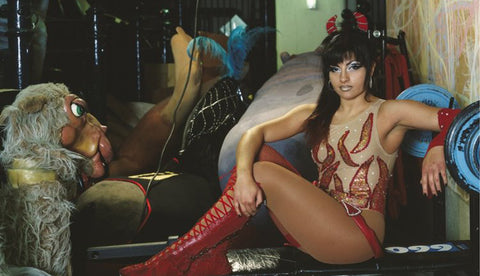Peter Lavery: Circus Work

Author: Peter Barker
Excerpt taken from https://www.peterbarker.org
"Peter Lavery’s "Circus Work" is a set of images of circus performers taken over the last forty years on large format cameras which encapsulates a world of physicality, daring and toughness at the centre of which is the human form. I saw them at the Harley Gallery earlier in the year and the exhibition is now showing at the RWA in Bristol as part of its “Sawdust And Sequins” celebration of the 250th anniversary of circus performance.
The photographs which most caught my eye were the earlier monochrome platinum prints. There are no audiences and few ringside, context or, performance shots. The subject of each image is a human being or a group of them who, by fate or taste or circumstance have chosen to live their lives for the time being at least as circus performers.
They are historical in two senses. Firstly the subjects are clearly not doing this job for the money- they are doing it for the sake of doing it – which is a rarity in the 21st century. Secondly, the images record the closing years of an era when occupation was identity. You could tell by clothes, bearing, speech and manner who someone was very much more than you can now.
Peter Lavery started taking the photographs when he was a student in the 1970s. As he got to know many of his subjects better he was able to separate them from their professional persona and their performance. What emerges from that development of relationships is a remarkable series of portraits. The prints are not large and tend towards the mid-tones which gives them a certain intimacy: you have to stand close to see them properly. The backgrounds are nondescript without being dismal: canvas tenting, dressing rooms, shrubbery and fields.
The hairstyles, the costumes, the props and accessories all root the monochrome photographs in what now seems like prehistory but was in fact only a few decades ago. But this is an irrelevance: it is the subjects themselves that fix the eye. These are people who are used to being looked at. They show no self-consciousness. The camera looks at them and they look straight back at the camera. They seem to have nothing to hide.
Then there is their physicality. These are circus performers: trapeze artists, contortionists, jugglers, clowns, strongmen and animal trainers. Most of them live with danger every day. Broken limbs, injuries, cuts and bruises are a commonplace. They exude a physical confidence which makes it difficult to look away. They are very beautiful in a sense which has almost been forgotten, they are beautiful in their style. These are muscular, toned but by no means perfect bodies – more like performance machines than objects of desire.
There are also more modern, larger, colour prints. They are equally impressive but colour changes everything. It is a code which is much more difficult to decipher and the effort to do so can lead the eye away from the subject.
I find it helps to think of all the ways in which a circus and its performers might be photographed to appreciate this exhibition. You might want to show daring or drama, the contrast of drabness and glamour, or some strange and slightly surreal aspect (think Mary Ellen Mark’s circus series, for example). But Peter Lavery has extracted something ineffable which in its ordinariness is remarkable."
Article by Peter Barker. Read the full piece at peterbarker.org/blog
All photos copyright and by kind permission of Peter Lavery
Sawdust and Sequins:The Art of the Circus continues until 3 June 2018